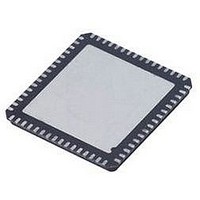AD9548BCPZ Analog Devices Inc, AD9548BCPZ Datasheet - Page 30

AD9548BCPZ
Manufacturer Part Number
AD9548BCPZ
Description
IC CLOCK GEN/SYNCHRONIZR 88LFCSP
Manufacturer
Analog Devices Inc
Datasheet
1.AD9548BCPZ-REEL7.pdf
(112 pages)
Specifications of AD9548BCPZ
Input
*
Output
*
Frequency - Max
*
Voltage - Supply
*
Operating Temperature
*
Mounting Type
Surface Mount
Package / Case
88-LFCSP
Frequency-max
*
Clock Ic Type
Clock Synthesizer
Ic Interface Type
Serial
Frequency
1GHz
No. Of Outputs
4
No. Of Multipliers / Dividers
4
Supply Current
190mA
Lead Free Status / RoHS Status
Lead free / RoHS Compliant
Available stocks
Company
Part Number
Manufacturer
Quantity
Price
Part Number:
AD9548BCPZ
Manufacturer:
ADI/亚德诺
Quantity:
20 000
Company:
Part Number:
AD9548BCPZ-SMD7
Manufacturer:
SHARP
Quantity:
392
AD9548
REFERENCE SWITCHOVER
An attractive feature of the AD9548 is its versatile reference
switchover capability. The flexibility of the reference switchover
functionality resides in a sophisticated prioritization algorithm
coupled with register-based controls. This scheme provides the
user with maximum control over the state machine that handles
reference switchover.
The main reference switchover control resides in the loop
mode register (Address 0A01). The user selection mode bits
(Register 0A01, Bits[4:3]) allow the user to select one of the
reference switchover state machine’s four operating modes, as
follows:
In automatic mode, a fully automatic priority-based algorithm
selects which reference is the active reference. When programmed
for automatic mode, the device ignores the user selection
reference bits (Register 0A01, Bits[2:0]). However, when pro-
grammed for any of the other three modes, the device makes
use of the user reference bits. These bits specify a particular
input reference (000 = REF A, 001 = REF AA ..., 111 = REF DD).
In fallback mode, the user reference is the active reference
whenever it is valid. Otherwise, the device switches to a new
reference using the automatic, priority-based algorithm.
In holdover mode, the user reference is the active reference
whenever it is valid. Otherwise, the device switches to holdover
mode.
In manual mode, the user reference is the active reference
whether it is valid or not. Note that, when using this mode, the
user must program the reference-to-profile assignment (see
register 0503 to Register 0506) as manual for the particular
reference declared as the user reference. The reason is that if the
user reference fails and its redetect timer expires, then its profile
assignment (shown in Table 22) becomes null. This means that
the active reference (user reference) does not have an assigned
profile, which places the AD9548 into an undefined state.
The user also has the option to force the device directly into
holdover or free-run operation via the user holdover and user
free-run bits (Register 0A01, Bit 6 and Bit 5, respectively]). In
free-run mode, the free running frequency tuning word register
(Address 0300 to Address 0305) defines the DDS output
frequency. In holdover mode, the DDS output frequency
depends on the holdover control settings (see the Holdover
section).
Automatic Priority-Based Reference Switchover
The AD9548 has a two-tiered, automatic, priority-based
algorithm that is in effect for both automatic and fallback
Automatic mode (Address A01, Bits[4:3] = 00)
Fallback mode (Address 0A01, Bits[4:3] = 01)
Holdover mode (Address 0A01, Bits[4:3] = 10)
Manual mode (Address 0A01, Bits[4:3] = 11)
Rev. A | Page 30 of 112
reference switchover. The algorithm relies on the fact that each
reference profile contains both a selection priority and a
promoted priority. The selection and promoted priority values
range from 0 (highest priority) to 7 (lowest priority). The
selection priority determines the order in which references are
chosen as the active reference. The promoted priority is a
separate priority value given to a reference only after it becomes
the active reference.
An automatic reference switchover occurs on failure of the
active reference or when a previously failed reference becomes
valid and its selection priority is higher than the promoted
priority of the currently active reference (assuming that the
automatic or fallback reference switchover is in effect). When
performing an automatic reference switchover, the AD9548
chooses a reference based on the priority settings within the
profiles. That is, the device switches to the reference with the
highest selection priority (lowest numeric priority value). It
does so by using the reference-to-profile table (see Table 22) to
determine the reference associated with the profile exhibiting
the highest priority.
If multiple references share the same profile, then the device
chooses the reference having the lowest index value. For
example, if the A, B, and CC references (Index 0, Index 2, and
Index 5, respectively) share the same profile, then a switchover
to Reference A occurs because Reference A has the lowest index
value. Note, however, that only valid references are included in
switchover of the selection process. The switchover control logic
ignores any reference with a status indication of invalid.
The promoted priority parameter allows the user to assign a
higher priority to a reference after it becomes the active
reference. For example, suppose four references have a selection
priority of 3 and a promoted priority of 1, and the remaining
references have a selection priority or 2 and a promoted priority
of 2. Now, assume that one of the Priority 3 references becomes
active because all of the Priority 2 references have failed. Some-
time later, however, a Priority 2 reference becomes valid. The
switchover logic normally attempts to automatically switch over
to the Priority 2 reference because it has higher priority than the
presently active Priority 3 reference. However, because the
Priority 3 reference is active, its promoted priority of 1 is in
effect. This is a higher priority than the newly validated
reference’s priority of 2, so the switchover does not occur. This
mechanism enables the user to give references preferential
treatment while they are selected as the active reference. An
example of promoted vs. nonpromoted priority switching
appears in state diagram form in Figure 35. Figure 36 shows a
block diagram of the interrelationship between the reference
inputs, monitors, validation logic, profile selection, and priority
selection functionality.














